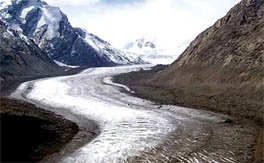Himalayan glaciers: a state-of-art review of glacial studies, glacial retreat and climate change
This paper on the state of Himalayan Glaciers by V K Raina, ex Deputy Director of GSI presents a historical review of the research to date spanning more than fifty years, and claims that it is premature to accept that Himalayan glaciers are retreating abnormally because of global warming.
Monitoring of a glacier, in specifi c terminology, means the study of glacier growth or degeneration over a specifi c period of time, laterally, vertically and in its longitudinal profi le. Monitoring of glaciers, sensu stricto, is restricted to the study of the glacier snout, i.e., the front end of the glacier. The general belief is that the snout or the lowest extremity of a glacier refl ects its health. A glacier in the Himalayas, on average, moves downward at a daily rate of one to three cm along the lower limits. It was the general belief of early glaciologists that the snout, in certain respects, denoted the altitudinal level where the melting of the glacier ice caused by the increased temperature of lower altitudes balanced the glacier


